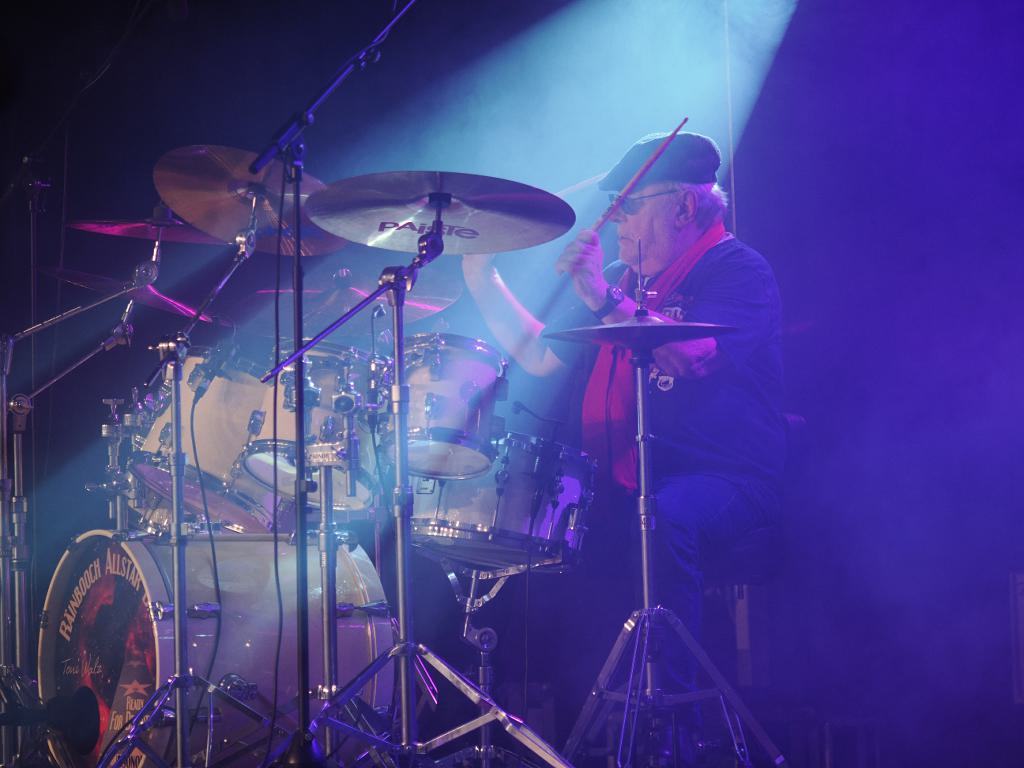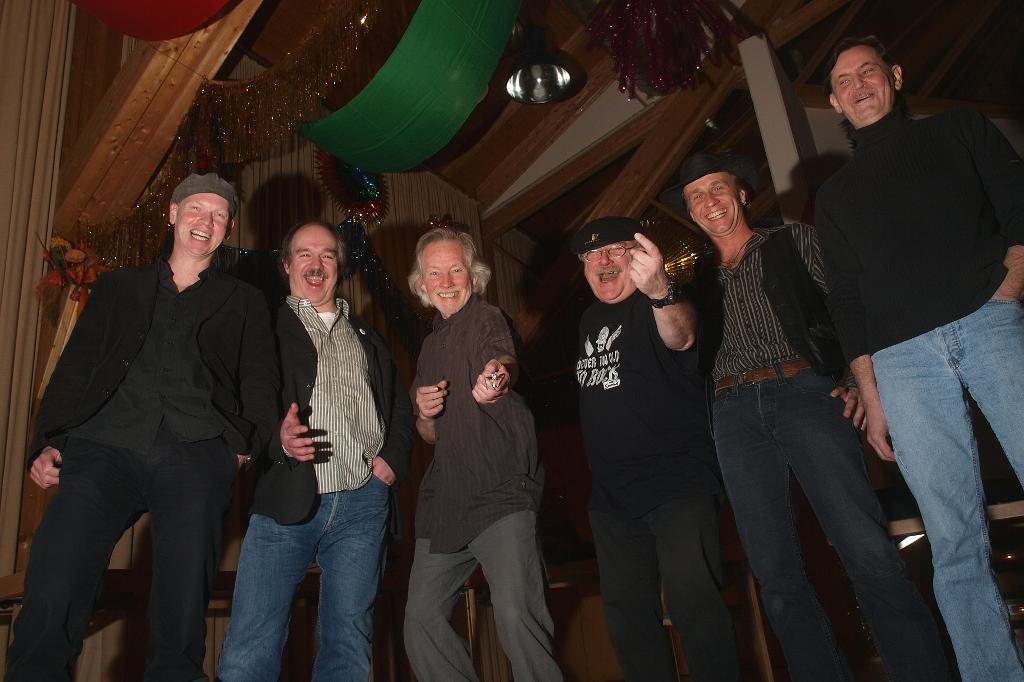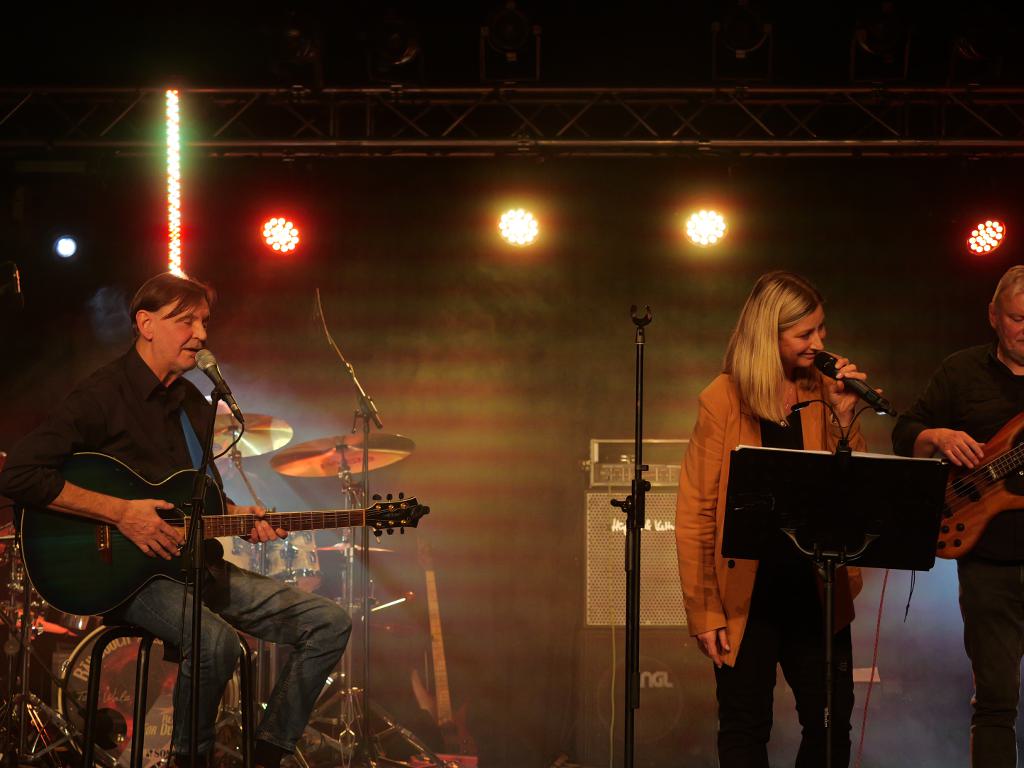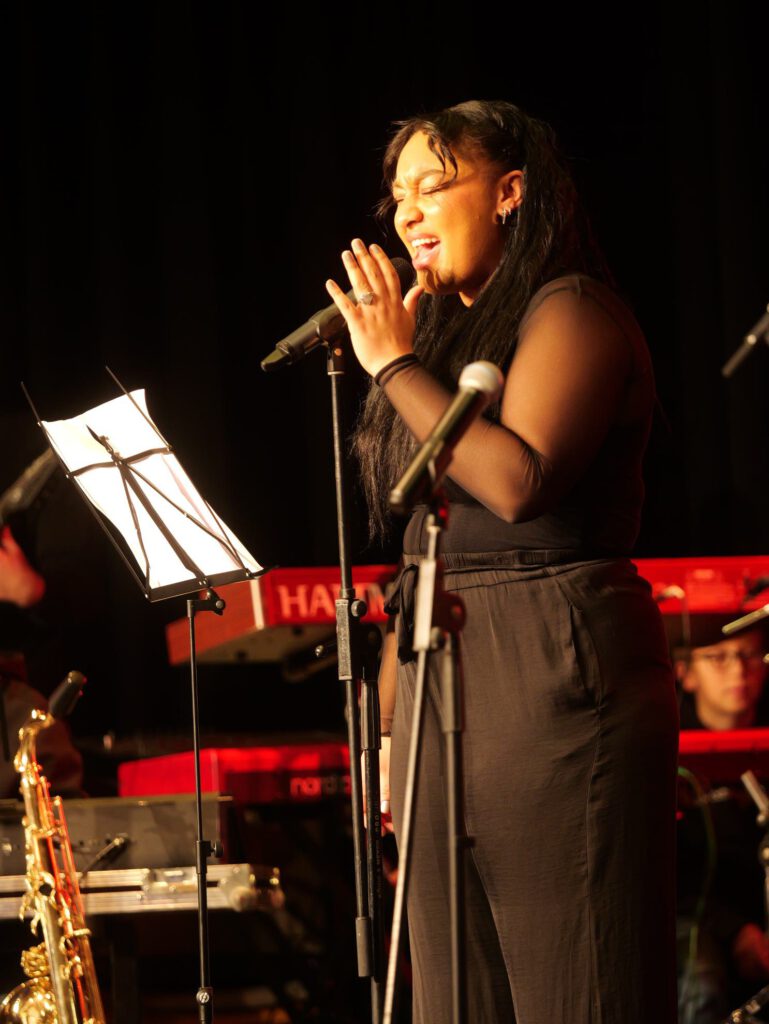
Two weeks ago on Saturday I was on stage again. The big band of the GSG Röthenbach an der Pegnitz, the HotSkills and the Räinbooch Allstars. (The drummer of the Allstars is something of a legend, having drummed for Tony Sheridan. The same guy who once recorded a record with a completely unknown band from Liverpool: “The Beat Brothers”. After the Allstars once performed on stage with Klaus Voormann, they have a certain reputation …. )

So I set off with the GF9II, 12-60 and 40-150. Because I only have one battery for the GF9II, I packed the OM-1 and some old FT glass as a backup. Which I was very happy about in the end.
Flickering light – I’ve already written about that.
In the town hall in Röthenbach (where, by the way, the photo with Voormann was taken at the time), pulsed LED spotlights are now installed in the light show. The nasty thing about the G9II is that you only see this when you look at the pictures, as the camera has flicker suppression that cannot be switched off. So be sure to activate the capture view, otherwise you’ll end up with pictures full of streaks until the first chimp.

Recording view.
You should also activate the shooting view for another reason. If you press the shutter release button in quick succession, the viewfinder image disappears. All you see is black with a gray haze. That’s a bit silly. With the shooting view activated, you can at least briefly see the last picture taken. (This is different from the OM-1, which does not activate the shooting view at all when the shutter release button is pressed halfway, but always switches to LiveView).
Switch-on delay
I have already mentioned that the camera takes an annoyingly long time to show a sign of life after switching on. You can switch off the OM-1 when you don’t need it. Leave the G9II switched on if you don’t have five seconds to take a photo. Five seconds can be too long if you don’t want to miss the sax solo. By the way: always wake up the camera from sleep. This can only be done with the shutter release, not with every button as with the Oly. Because as soon as it has fallen into a deep sleep, the camera needs 5 seconds to wake up again. Unfortunately, there is no way to switch off this deep sleep mode or even to find out when the camera switches to it. I couldn’t find anything about this in the 832-page manual.
Autofocus.
How do I tell my child…. Let’s put it this way: Nope.
The autofocus fluctuates. You have the AF point rock-solid at one point, you yourself don’t move, the person doesn’t move, the image section is the same and yet the AF pumps and delivers different focus positions in a series of images within a second. And it doesn’t matter whether S-AF or C-AF. Whether you stay halfway on the shutter release or go down between releases. You can also see that the lens defocuses and refocuses in between – for no reason at all. This may work with moving birds in good light. On stage, this is disastrous. Apparently Panasonic has tried to wrest a fast AF from the slow sensor and concentrated on wildlife and video. These are the two applications that are currently “hip” and being tested by bloggers.
During my first attempts in low light, I was impressed that the camera always triggers, always finds focus, where the OM-1 pumps desperately. Tcho. On closer inspection it turned out – yes, it claims to have found a focus. Sometimes somewhere else – far away from the focus point – sometimes the term “focus” is interpreted very generously, sometimes it triggers even though nothing is in focus far and wide. It is “better” with the Lumix 12-60, worse with the m.Zuiko 40-150. “Nearest is best” – the “core competence” of phase AF – works according to the blinker principle: works, doesn’t work, works, doesn’t work. According to my investigations, we are dealing with a mix of phase AF and contrast AF using the old Pana DFD method. Phase AF is responsible for the rough distance, and then switches to the old contrast AF in the area of the subject. And not the “normal” one as with the Olys, but Pana’s own, which defocuses first. The result is disastrous. 40-50% rejects are normal.

I immediately informed Panasonic about this and also attached sample pictures. (And added user reports from other sites that have the same problem. Grossly unreliable AF and black viewfinder after a few pictures). After two weeks, no response on this issue.
Internet reviews emphasize the particular reliability of face detection. The first face that the Pana recognized in my case was my open folder in which the printed manual for the Pana was filed. When I tried with my mannequin, the camera recognized the face when I placed the AF point over the face. (BTW: moving the AF point with the “joystick” is not a “joy”. Either the thing was broken or it’s just bad).
I also checked to see if I accidentally activated shutter priority – nope. Focus priority.
I then switched to the OM-1 with the 35-100, every shot a hit. And you can immediately see in the viewfinder which lights are responsible for the flickering. And you can switch from electric to mechanical shutter in the SCP – with the Pana you have to go into the menu first. (Yes, you can put the electronic shutter in the Q menu. )
Conclusion: Stage photography with the G9II requires a prior adjustment of the camera and a new way of working that is more reminiscent of the old DSLRs. A lot of chimping and precise focus control, working slowly, hoping that you catch the exact facial expression and that the AF just happens to fit. “One shot” pictures are a big risk. Always take several shots of a subject and hope that the really spectacular facial expression is among “the good ones”.
Unfortunately, a G9II with any lens currently available is hopelessly inferior to an OM-1 with 14-35 and 35-100. You have to accept that. (Yes, there is the 10-25 and the 25-50. Unfortunately, Pana did not provide me with these two lenses for testing. But after the tests with the 12-60 as well, I don’t have high hopes).
The cover picture? From the OM-1 with the 35-100. The G9II had an impressive error rate of 83% with the drummer in the haze with backlight. Anyone who has ever photographed drummers knows that the camera has to deliver. And quickly, otherwise someone will be in the way, the drummer will be back on the snare and hi-hat and the moment will be over. Normally it’s three songs. If you don’t have your photos in the can, you don’t get a second chance. You can forget about long chimps in the pit.
Hallo Reinhard,
Vielen Dank für den interessanten Bericht. Ich habe mir die G9II auch bestellt, allerdings für Landschaft und Macro und als weitere Option fürs Filmen.
Was meinst du, wie hätte sich die OM-1 mit mft Objektiven im Vergleich geschlagen? Das FT Altglas habe ich leider nicht.
Ich habe natürlich auch das 40-150 an der OM-1 geschnallt. Piece of cake. Alle scharf. Aber ich sollte ja auch abliefern und da ist natürlich das Bessere der Feind des Guten. Also TopPros drauf.
Makro: Die G9II kann kein Stacking. Und sie legt bei Objektiven mit internem Stabi (90er Makro) den Stabi der Kamera lahm. (Auch wenn man den Stabi des Objektivs ausschaltet.) Die Sucherlupe der Oly ist besser, der AF sowieso. Man kann mit der Oly beim Bracketing blitzen (kann die Pana nicht, die weigert sich beim elektronischen Verschluss zu blitzen)
Also: gerade für Makro wäre ich nicht auf die Idee gekommen, die G9II zu kaufen…
Für’s Filmen: Im professionellen Bereich, mit Nachbearbeitung, bietet die Pana mehr. Auch die hohen Bildraten. Ich filme nur FHD und verbringe so wenig Zeit wie möglich am Schneidetisch und mag keine ausufernde Slomo – da ist die E-M1II/III/X weit überlegen.
Das der Joystick zum Verschieben des Fokuspunktes bei der G9II kein “joy” ist kann ich seit gestern leider bestätigen.
Und es hat mich gewundert, denn bei der S5 (I) funktioniert das einwandfrei, zielsicher und schnell.